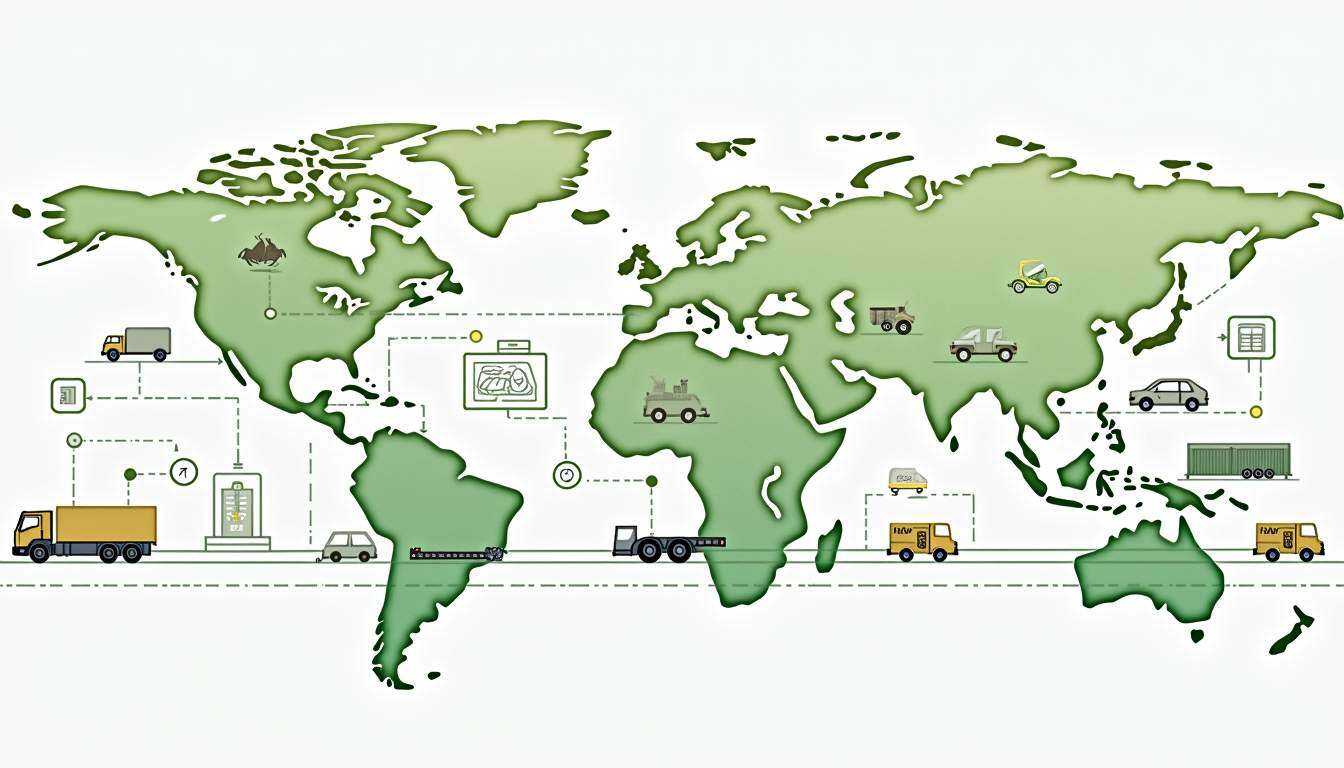Share this
Ecommerce Logistics Optimization 101
by Shipfusion Team on Apr. 29, 2025

Ecommerce is defined by speed, accuracy, and the seamless movement of goods from warehouse to customer. As order volumes surge and buyer expectations intensify, ecommerce logistics optimization has shifted from a nice-to-have to a core requirement for scaling successfully. Every decision – from the placement of fulfillment centers to the integration of order management software – affects profitability, brand reputation, and customer retention.
This guide outlines practical, scalable strategies for ecommerce logistics optimization, enabling businesses to run leaner operations, reduce costs, and exceed delivery expectations in a demanding marketplace.
The Fundamentals of Ecommerce Logistics Optimization
Logistics optimization means fine-tuning each component of your supply chain – from inventory storage to last-mile delivery – to increase speed and efficiency while minimizing cost and waste. In ecommerce, this requires a proactive and tech-enabled approach. Consumer expectations now include next-day or even same-day shipping, order accuracy near 100%, and easy return policies. The pressure on fulfillment operations has never been higher.
Poorly optimized logistics can lead to a cascade of problems: slow delivery times, excess shipping fees, rising warehouse costs, poor inventory control, and negative customer reviews. Businesses that invest in smart logistics strategies often see the opposite – lower costs, faster turnaround, and improved customer lifetime value.
Targeting Cost Efficiency Without Sacrificing Quality
While logistics expenses often eat into profit margins, cutting corners on service can harm your brand. The goal is to eliminate waste and inefficiencies – without degrading the customer experience.
Supplier and Carrier Rate Optimization
Bulk negotiating with carriers or joining third-party fulfillment networks can unlock volume-based discounts. Comparing regional versus national shipping rates, using zone-skipping strategies, and leveraging real-time rate shopping can prevent overspending on freight.
Smarter Inventory Allocation
Poor inventory positioning – such as storing all SKUs in one warehouse hundreds of miles from your core customers – leads to longer delivery times and higher shipping fees. Distributed inventory allows orders to be fulfilled from the location closest to the customer.
Couple that with demand forecasting software, and you can cut carrying costs while reducing the risk of stockouts or overstocks.
Packaging and Dimensional Weight Management
Packaging affects shipping cost more than many realize. Carriers use dimensional (DIM) weight pricing, meaning that inefficient or oversized packaging increases costs – even when shipping light items.
Streamlined packaging design and automation not only reduce DIM weight fees but also speed up the packing process and lower material waste.
Improving Speed and Accuracy of Fulfillment
Customers expect accurate orders delivered at breakneck speed. Fulfillment delays or errors are among the fastest ways to lose trust – and a future sale. Streamlining internal warehouse operations can dramatically improve both metrics.
Distributed Fulfillment Centers
Multiple strategically located fulfillment centers help reduce average shipping time and cost. If your customer base is spread across North America, operating out of a single central warehouse won’t cut it.
Many ecommerce brands are moving toward decentralized fulfillment models, especially as shipping zones play a greater role in pricing and speed.
Automation Across the Fulfillment Workflow
Automation eliminates manual steps that slow down operations or introduce human error. Integrating warehouse management systems (WMS), barcoding, pick-to-light systems, and even robotics reduces fulfillment time and increases accuracy.
By implementing automated packing stations and real-time inventory syncing, ecommerce companies can ensure customers receive the correct items faster – without scaling labor costs at the same rate as order volume.
Real-Time Tracking and Customer Transparency
Modern logistics isn’t just about shipping. It’s about visibility. Customers want proactive updates and control over their deliveries. Delays are tolerated, but only when communicated transparently.
Ensure your logistics platform supports real-time tracking, shipment confirmation emails, and easy returns initiation. This improves customer satisfaction and reduces the volume of support inquiries.
Leveraging Technology for Smarter Logistics
Technology isn’t an optional enhancement – it’s the foundation of modern logistics optimization. The right tech stack creates a centralized view of your operations, allowing you to automate, forecast, and pivot with agility.
Warehouse Management Systems (WMS)
A WMS helps manage every aspect of warehouse operations – from inventory tracking and receiving to picking and packing. It reduces human error, speeds up order processing, and ensures optimal space utilization.
Advanced Example: A WMS integrated with IoT sensors can automatically reallocate pick zones based on order frequency, reducing picker travel time and accelerating fulfillment.
Transportation Management Systems (TMS)
A TMS enables shippers to compare carrier rates in real time, manage label printing, track shipments, and analyze delivery performance. TMS data also supports route optimization, especially for businesses handling local deliveries or bulk B2B/wholesale ecommerce orders.
Inventory Management Platforms
With inventory syncing across sales channels and warehouse locations, businesses can avoid overselling, underselling, or misallocating stock. Forecasting features use historical data to prepare for seasonal spikes, promotions, or slowdowns.
Look for software that allows multi-warehouse support, dynamic safety stock alerts, and integration with your ecommerce storefronts.
Optimizing Your Supply Chain Network
Your supply chain is only as strong as its weakest link. An agile, diversified network minimizes disruptions and keeps fulfillment resilient even during unexpected events like supply shortages, weather disruptions, or labor strikes.
Diversified Supplier Base
Relying on a single supplier creates a single point of failure. Diversify vendor relationships, qualify regional or domestic suppliers where possible, and ensure you have backup options for critical SKUs.
Demand-Based Distribution Models
Instead of static inventory placement, dynamic distribution models use real-time demand signals to reposition inventory across warehouses. This ensures popular items stay closer to end consumers, cutting delivery time and cost.
Just-in-Time Inventory
JIT inventory models reduce holding costs and warehouse space needs by ensuring inventory arrives shortly before it’s needed. While not ideal for all products (especially high-turn or perishable goods), JIT works well for slower-moving SKUs or bulky items.
Cross-Team Communication and Transparent Data
No optimization effort succeeds in isolation. Your fulfillment team needs visibility into marketing promotions, sales trends, and customer support feedback – while those departments need logistics data to inform decisions.
Centralized Communication Tools
Using a shared dashboard or collaborative logistics platform allows real-time updates between teams. For example, when marketing runs a flash sale, logistics managers should receive automatic alerts to prepare for volume surges.
Regular Business Reviews with Logistics Partners
Whether working with a 3PL or managing fulfillment in-house, scheduling regular operations reviews fosters continuous improvement. Discuss supply chain KPIs, root causes of any SLA misses, and upcoming operational changes.
Proactive Customer Service Alignment
Support teams should be equipped with real-time order statuses and return workflows, so they can address customer concerns quickly without relying on back-and-forth with the warehouse team.
KPIs That Signal Effective Ecommerce Logistics Optimization
Tracking the right performance metrics allows you to evaluate what’s working and identify areas that need further refinement.
1. Order Cycle Time
This includes order processing, picking, packing, and delivery. A decreasing average cycle time generally indicates better optimization across fulfillment stages.
2. Perfect Order Rate
Combines accuracy, on-time delivery, and undamaged product receipt. This customer-centric KPI reflects the end-to-end success of your logistics.
3. Inventory Turnover Ratio
Too low suggests overstocking and excess holding costs. Too high may risk stockouts. An optimized turnover rate reflects strong demand planning and product flow.
4. Shipping Cost as a % of Revenue
Keeping this ratio steady – or reducing it as order volume grows – shows that logistics scaling is cost-effective. High percentages may signal inefficiencies or missed opportunities for consolidation or automation.
5. Return Rate and Return Processing Time
High return rates could indicate quality or listing issues. Long processing times frustrate customers and delay resale or refunds. Optimized reverse logistics makes returns a competitive advantage instead of a cost sink.
Shipfusion Does Ecommerce Logistics Optimization at Scale
Mastering ecommerce logistics optimization is one of the most impactful levers for long-term success in online retail. It connects every aspect of your business – customer satisfaction to cost control, scalability, and brand loyalty. With the right combination of technology, distributed fulfillment, proactive inventory management, and data-driven decisions, you can turn logistics into a strength, not a stressor.
Shipfusion exists to power that transformation. As a full-service 3PL specializing in ecommerce fulfillment, we provide more than just warehouses – we offer infrastructure built to scale with your brand. Our platform provides real-time visibility into inventory, orders, and performance, while our strategically located North American warehouses reduce transit times and shipping costs. Dedicated Account Managers ensure a hands-on approach, and our proprietary software keeps every part of your supply chain connected.
If you're ready to eliminate inefficiencies and elevate your fulfillment experience, let’s talk. Explore Shipfusion’s pricing and solutions today, and see how our ecommerce logistics optimization expertise can empower your next stage of growth.
Share this
You May Also Like
These Related Articles

The Key Ingredients of a Successful 3PL Agreement and Partnership

How to Navigate Your Local Carrier Center Efficiently

Companies Who Don't Offer Free Shipping But Succeed Anyway
- April 2025 (25)
- March 2025 (26)
- February 2025 (26)
- January 2025 (37)
- December 2024 (16)
- November 2024 (23)
- October 2024 (22)
- September 2024 (27)
- August 2024 (9)
- July 2024 (8)
- June 2024 (5)
- May 2024 (8)
- April 2024 (8)
- March 2024 (6)
- February 2024 (6)
- January 2024 (5)
- December 2023 (3)
- November 2023 (3)
- October 2023 (5)
- September 2023 (4)
- August 2023 (2)
- July 2023 (1)
- June 2023 (4)
- March 2023 (2)
- October 2022 (1)
- September 2022 (5)
- August 2022 (4)
- July 2022 (7)
- June 2022 (4)
- May 2022 (4)
- April 2022 (6)
- March 2022 (2)
- February 2022 (1)
- January 2022 (3)
- December 2021 (2)
- November 2021 (4)
- October 2021 (2)
- September 2021 (5)
- August 2021 (4)
- July 2021 (4)
- June 2021 (3)
- May 2021 (2)
- April 2021 (3)
- March 2021 (3)
- February 2021 (3)
- January 2021 (2)
- December 2020 (4)
- November 2020 (2)
- October 2020 (4)
- September 2020 (2)
- July 2020 (5)
- June 2020 (4)
- May 2020 (2)
- April 2020 (2)
- March 2020 (4)
- February 2020 (1)
- December 2019 (1)
- May 2018 (1)
- March 2018 (2)
- February 2018 (3)
- January 2018 (3)
- November 2017 (3)
- July 2017 (4)
- March 2017 (3)
- February 2017 (5)
- January 2017 (3)
- December 2016 (4)
- November 2016 (6)
- October 2016 (6)
- October 2015 (1)
- September 2015 (1)
- June 2015 (3)
- May 2015 (3)
- August 2014 (1)
- July 2014 (1)
- March 2014 (1)
- February 2014 (1)